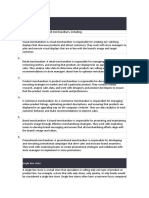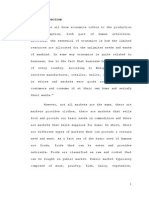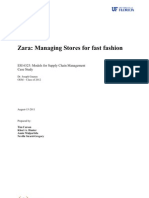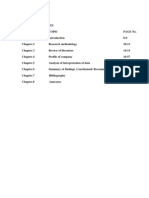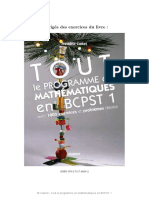Talbots
Talbots
Uploaded by
Guru ChowdharyCopyright:
Available Formats
Talbots
Talbots
Uploaded by
Guru ChowdharyOriginal Description:
Copyright
Available Formats
Share this document
Did you find this document useful?
Is this content inappropriate?
Copyright:
Available Formats
Talbots
Talbots
Uploaded by
Guru ChowdharyCopyright:
Available Formats
Q) Discuss the store operations and SCM of Talbots?
Ans: during the 1990s Talbots continued to add new stores to strengthen its
customer base. By 2000 it had 673 stores in 45 states Canada and UK. Stores
concepts included Talbots petite, misses store, kids store and accessories store.
Talbot offered women complete wardrobe dressing experience for all occasions.
The staff in their stores was knowledgeable and experienced unlike other
departmental store and helped the customer by assisting them in selecting the
garments that they need.
Tablot misses store offered range of styles in career and casual clothing where
each style was composed of 2-4 garments in 3-6 colour combinations. There
were around 363 stores averaging 5000 sq ft and carried misses sizes and petite
assortment. They were located in freestanding locations and downtown shopping
areas. Talbot petite targeted women shorter than 54 and 400-500 assortment
was an edited assortment of misses store. There were 140 stores averaging 2500
sq ft. Talbot kids offered high quality durable clothing to infant and up to 14
years old children. These stores averaged 3100 sq ft and there were around 57
stores.
Talbots accessories and shoes were around 1900 sq ft nad had 33 stores and also
included belts, scarves, purses and other accessories. Talbot woman was a new
concept where they had initially 5 stores serving women sized 12W-24W.
The store was distinguished by the signature red door created for each of its
store brands. The interior was such that it gave a residential feel and was used
consistently to promote familiarity, ease of shopping for customers and cost
savings. Kids store were designed to have a light atmosphere and the store was
allocated inventory based on their size and selling history. It positioned itself as a
limited promotion retailer offering four sale events annually. For most stores it
leased the store locations. Stores were usually managed by a store manager and
2 assistant managers. Store manager reported to district managers responsible
for 8-10 stores. The district manager was responsible for sales, operating costs
etc. district managers reported to 8 regional directors and the regional directors
reported to 3 territorial directors.
SCM
After the product development group presented its idea the buying group was
responsible for quantifying the specific merchandise and departmental needs
and plans. Then the sourcing staff used these plans to place specific item orders
on styles developed in conjunction with the product development office and
other vendors. Talbot purchased half of its merchandise from offshore vendors
located in Hong kong, Jakarta and rest from US and Europe. Talbot hong kong
office handled 67% offshore sourcing while agents did the rest 33%. Independent
foreign factories located in Hong kong and other Asian countries manufactured
directly sourced merchandise and all these were placed order by order basis so
they didnt had any contractual agreement to purchase from them. The Lakeville
distribution centre received, processed and distributed all merchandise for
Talbots catalogues and stores. The merchandise received was inspected,
assigned to individual stores, packed for delivery and shipped to stores with each
store receiving merchandise twice a week.
You might also like
- Clothing Retail Business PlanDocument11 pagesClothing Retail Business PlanAlhaji Daramy100% (2)
- Rizal - S Education in Manila and UST HistoryDocument5 pagesRizal - S Education in Manila and UST HistoryPrimo George100% (1)
- Wal-Mart - Org Structure and StrategyDocument24 pagesWal-Mart - Org Structure and StrategyShreshtha Rath88% (24)
- Walmart Foreign Expansion - ReportDocument27 pagesWalmart Foreign Expansion - Reportida barrieNo ratings yet
- CLC Attracting and Retaining Critical Talent Segments Identifying Drivers of Attraction and Commitment in The Global Labor MarketDocument191 pagesCLC Attracting and Retaining Critical Talent Segments Identifying Drivers of Attraction and Commitment in The Global Labor MarketGuru Chowdhary100% (1)
- The Sabbath of Colossians 2 16 PDFDocument13 pagesThe Sabbath of Colossians 2 16 PDFTessy AjiNo ratings yet
- Situation AnalysisDocument59 pagesSituation AnalysisakuhunnyNo ratings yet
- CLC Preparing Your Employment Value PropositionDocument36 pagesCLC Preparing Your Employment Value PropositionGuru Chowdhary100% (1)
- Creative Strategy, Tactics & ExecutionDocument5 pagesCreative Strategy, Tactics & ExecutionGuru Chowdhary100% (2)
- Atlas of Mysterious Places PDFDocument248 pagesAtlas of Mysterious Places PDFinspicous100% (5)
- Wayfinding Sans ProDocument26 pagesWayfinding Sans ProLuiz Carlos Fetter0% (1)
- Lodge - Hotel Des BoobsDocument5 pagesLodge - Hotel Des BoobsGeorgian BujorNo ratings yet
- Types of Retail FormatsDocument8 pagesTypes of Retail FormatsSystech SysNo ratings yet
- A Survery of Outlet Mall RetailingDocument22 pagesA Survery of Outlet Mall RetailingsoucaamaliamariaNo ratings yet
- Walmart: Crafting & Executing StrategyDocument31 pagesWalmart: Crafting & Executing StrategyDivya LekshmiNo ratings yet
- Minneapolis Market Visit Target Town February 2011Document23 pagesMinneapolis Market Visit Target Town February 2011Aldo SianturiNo ratings yet
- Entrepreneur Assignment On Boutiq House ShokalDocument18 pagesEntrepreneur Assignment On Boutiq House ShokalMãrúfAhmêdNo ratings yet
- Zara 3Document4 pagesZara 3ROSE0% (1)
- Types of Retail FormatsDocument8 pagesTypes of Retail Formatsttanveerkaur50% (2)
- Store Operations Assisstant Class XDocument90 pagesStore Operations Assisstant Class Xparthgupta1026No ratings yet
- Company ProfileDocument9 pagesCompany Profilearichandranagilan539No ratings yet
- Retail Management - BakerstreetDocument29 pagesRetail Management - BakerstreetWan NieNo ratings yet
- Store OperationsDocument25 pagesStore Operationsmohsin techNo ratings yet
- Assignment 7 - Marketing Organisation of ZARADocument5 pagesAssignment 7 - Marketing Organisation of ZARAvikas giriNo ratings yet
- Food RetailingDocument14 pagesFood RetailingashakalyanibNo ratings yet
- Retail BusinessDocument82 pagesRetail BusinessGabriel SolsticeNo ratings yet
- Consumer BehaviourDocument3 pagesConsumer BehaviourRajat RajoriyaNo ratings yet
- Marketing Project: Visit To A Retail StoreDocument20 pagesMarketing Project: Visit To A Retail StoreFidan Faisal100% (1)
- Retail MangagementDocument11 pagesRetail MangagementMahek GautamNo ratings yet
- Field WrokDocument44 pagesField WrokJohnLesterDeLeonNo ratings yet
- Retail CompaniesDocument1 pageRetail Companiesjaswanth reddyNo ratings yet
- Aims and ObjectivesDocument5 pagesAims and ObjectivesFirdous QureshiNo ratings yet
- Zara Stores v3Document6 pagesZara Stores v3Timothy T CarsonNo ratings yet
- Retail Buying and MerchandisingDocument28 pagesRetail Buying and Merchandisingniftmukesh0% (1)
- Retail Management4semDocument643 pagesRetail Management4semAnees Ahmad100% (1)
- Introduction To Departmental StoresDocument2 pagesIntroduction To Departmental StoresAyush AgarwalNo ratings yet
- About V MartDocument2 pagesAbout V MarttrivanmayurNo ratings yet
- Biz Plan - Retail ClothingDocument19 pagesBiz Plan - Retail ClothingOlubusayo Ogunmade100% (1)
- 1016 (Jyotsna Marisetty) - RM Assignment 1Document11 pages1016 (Jyotsna Marisetty) - RM Assignment 1Dabbu BaruaNo ratings yet
- Unit 4 Individual Project: Business Plan For: Mischievieous: Christina Tyra English 320 December 3 2010Document23 pagesUnit 4 Individual Project: Business Plan For: Mischievieous: Christina Tyra English 320 December 3 2010Christina TyraNo ratings yet
- Happy Go Shopping Mall FootfallDocument11 pagesHappy Go Shopping Mall FootfallTheresa RosalesNo ratings yet
- Retail Marketing (Tot)Document73 pagesRetail Marketing (Tot)Nikhil KumarNo ratings yet
- Lifestyle StoresDocument7 pagesLifestyle StoresSudharma VaradarajanNo ratings yet
- Chain StoresDocument10 pagesChain Storesrohendrapratapsingh4No ratings yet
- Swot of Westside: 1 Growth at Faster Pace 2 Brand Name of Tata's 3 Good Customers Base. 4apparals Are Cheaper 5 AttrativeDocument8 pagesSwot of Westside: 1 Growth at Faster Pace 2 Brand Name of Tata's 3 Good Customers Base. 4apparals Are Cheaper 5 AttrativeArsh MaanNo ratings yet
- Analyzing The Consumer Buying Behavior in PantaloonsDocument20 pagesAnalyzing The Consumer Buying Behavior in PantaloonsAazamNo ratings yet
- Aikee 2Document14 pagesAikee 2Mikee TaganaNo ratings yet
- Bài đọc thêm Zara & UniqloDocument5 pagesBài đọc thêm Zara & UniqloPhan Thị Thúy NgaNo ratings yet
- Retail Sector - Group 7Document81 pagesRetail Sector - Group 7Shantveer DodamaniNo ratings yet
- Body of Report 1.1 Objective: - Comparative Study of Consumer Behavior in Traditional OutletsDocument24 pagesBody of Report 1.1 Objective: - Comparative Study of Consumer Behavior in Traditional OutletsRajesh KholeNo ratings yet
- Business Plan33docxDocument13 pagesBusiness Plan33docxuniqueking909No ratings yet
- EDC 2.1-Zara&UNIQLODocument3 pagesEDC 2.1-Zara&UNIQLOYousra Zhar100% (1)
- Consumer Behaviour Towards Shoppers StopDocument24 pagesConsumer Behaviour Towards Shoppers StopAditi Jindal100% (2)
- DJ Garments WholesaleDocument21 pagesDJ Garments WholesaleCharanNo ratings yet
- Comparative ShoppingDocument4 pagesComparative Shoppingapi-324397954No ratings yet
- PariortsDocument17 pagesPariortsMehedi HasanNo ratings yet
- Davis Final ReportDocument29 pagesDavis Final ReportRohan KhilareNo ratings yet
- Marketing Report of ImtaizDocument8 pagesMarketing Report of ImtaizArpana PunshiNo ratings yet
- Introduction To Topic: "Customer Satisfaction Towards Shoppers Stop". It Is A VeryDocument4 pagesIntroduction To Topic: "Customer Satisfaction Towards Shoppers Stop". It Is A Veryuniversal printerNo ratings yet
- TopshopDocument12 pagesTopshop靖汶No ratings yet
- INVESTOR PDF 104 20071018200016Document2 pagesINVESTOR PDF 104 20071018200016abc718No ratings yet
- Merchandising Marks & Spencers IndiaDocument43 pagesMerchandising Marks & Spencers IndiaSrishti RautNo ratings yet
- Business Studies Project - Aarav BhardwajaDocument18 pagesBusiness Studies Project - Aarav BhardwajaAarav Bhardwaja100% (1)
- Retail StoresDocument24 pagesRetail Storesrawiaali056No ratings yet
- Internship Report ON Recruitment & Selection Process of Max: Submitted BY Shubhi Raizada (MB2014038)Document57 pagesInternship Report ON Recruitment & Selection Process of Max: Submitted BY Shubhi Raizada (MB2014038)AshutoshSharma100% (1)
- Branding a Store: How To Build Successful Retail Brands In A Changing MarketplaceFrom EverandBranding a Store: How To Build Successful Retail Brands In A Changing MarketplaceRating: 3 out of 5 stars3/5 (2)
- The Complete Idiot's Guides to Starting and Running a Thrift Store: Turn Old Merchandise into a Thriving New BusinessFrom EverandThe Complete Idiot's Guides to Starting and Running a Thrift Store: Turn Old Merchandise into a Thriving New BusinessNo ratings yet
- Blackberry Case SolutionDocument5 pagesBlackberry Case SolutionGuru ChowdharyNo ratings yet
- Massification of Luxury BrandsDocument3 pagesMassification of Luxury BrandsGuru ChowdharyNo ratings yet
- Flipkart Myntra PDFDocument14 pagesFlipkart Myntra PDFGuru Chowdhary0% (1)
- Sip SipDocument2 pagesSip SipGuru ChowdharyNo ratings yet
- Date: June 19, 2019 2 Merit List General Category (17 Vacant Seats)Document2 pagesDate: June 19, 2019 2 Merit List General Category (17 Vacant Seats)Suraj AgarwalNo ratings yet
- Glyphs CataDocument4 pagesGlyphs CataDuvier SotolongoNo ratings yet
- Allemande PDFDocument2 pagesAllemande PDFArun EbenezerNo ratings yet
- Formative Test 5Document3 pagesFormative Test 5Elisabete VieiraNo ratings yet
- Literature Review Animal FarmDocument5 pagesLiterature Review Animal FarmAnime HamzaNo ratings yet
- Past Tenses PracticeDocument10 pagesPast Tenses PracticeAnca Diana PaleuNo ratings yet
- Song List For BarasaoainDocument3 pagesSong List For BarasaoainJhopet PangilinanNo ratings yet
- Tech & Env Project 1 - Portland HouseDocument2 pagesTech & Env Project 1 - Portland Houseapi-290631767100% (1)
- Tout Leprog Maths Bcpst1corriges PDFDocument339 pagesTout Leprog Maths Bcpst1corriges PDFaba armelNo ratings yet
- 01.monster Pet Evolution Chapter 1 - Chapter 50Document315 pages01.monster Pet Evolution Chapter 1 - Chapter 50Abdul Muqeet Rehan50% (2)
- Muhammad Sohail - January-June 2012Document29 pagesMuhammad Sohail - January-June 2012Umer HayatNo ratings yet
- Mor Ignatius Jacobite Syrian Orthodox Cathedral, Jebal Ali, Dubai Patriarch's VisitDocument3 pagesMor Ignatius Jacobite Syrian Orthodox Cathedral, Jebal Ali, Dubai Patriarch's VisitdaliyaNo ratings yet
- 008-Orthographic Projection (Detailed)Document27 pages008-Orthographic Projection (Detailed)Stevie NicksNo ratings yet
- 03.02 Planning Your Narrative: Grading Rubric "Grounded." Narrative Organization ChartDocument5 pages03.02 Planning Your Narrative: Grading Rubric "Grounded." Narrative Organization ChartjaifrmdaoNo ratings yet
- Paranormal Remedy To Avoid BankruptcyDocument7 pagesParanormal Remedy To Avoid BankruptcyanadinathNo ratings yet
- MATRIX 231 Ahmet OgutDocument2 pagesMATRIX 231 Ahmet Ogutdavid rockNo ratings yet
- Features of Narrative TextDocument20 pagesFeatures of Narrative TextMicah Eunice FanoNo ratings yet
- PW JanFeb 2006TOCDocument2 pagesPW JanFeb 2006TOCInterweaveNo ratings yet
- The Great Sacred SecretDocument25 pagesThe Great Sacred Secretapi-26203682No ratings yet
- Subject Link 1: Mid-Term Test: (1-5) Write The Correct Word For Each SentenceDocument6 pagesSubject Link 1: Mid-Term Test: (1-5) Write The Correct Word For Each SentenceYasser MohamedNo ratings yet
- HTML 1Document61 pagesHTML 1Tay Yu JieNo ratings yet
- Mqs ResumeDocument1 pageMqs Resumekyu remNo ratings yet
- All AroundDocument3 pagesAll AroundMohd AliNo ratings yet
- MSC 7Document3 pagesMSC 7Himanshi VohraNo ratings yet
- Fine Institute: Architecture Design VDocument8 pagesFine Institute: Architecture Design VamritagcadNo ratings yet




























